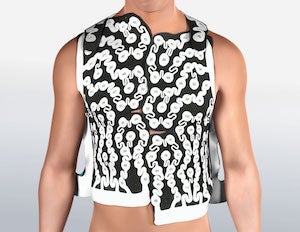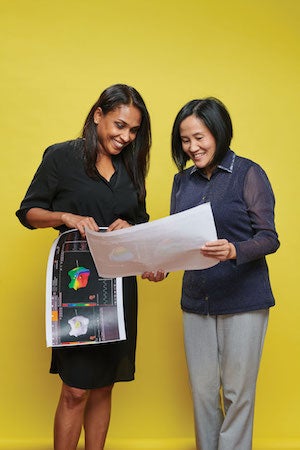FEATURES
Road Map to the Heart
Two graduate students turned entrepreneurs transformed a medical breakthrough from a lab project into a clinical tool. Years later, Medtronic bought the company they co-founded for $93 million.
Prologue
As a child in Kochi, India, Charu Ramanathan, PhD (GRS '00,'04, biomedical engineering), gathered armfuls of books from her mother and neighbors, loaded them onto her bike and pedaled around town, lending from her improvised library—for a fee.
Her goal wasn't to get rich; she wanted the ability to buy sweets at a neighborhood bakery.
In a way, everything Ramanathan did as a child prepared her for her role as startup co-founder.
"My parents will say that I always wanted it my way and I got my way, but they leave out the part that I had to work for it," she said. "I work hard."
Ping Jia, PhD (GRS '98, '05, biomedical engineering), also worked hard, in a makeshift laboratory in her childhood home in Beijing, producing oxygen and growing salt crystals from equipment she built out of household items.
"My family has three historical scholars, and my father had hoped I would also become one someday," she said. But instead, she looked to the stars—literally, assembling a telescope with her youth astronomy group—and let her love of science carry her all the way to Case Western Reserve.
Genesis
 IMAGE: Courtesy of Medtronic
IMAGE: Courtesy of MedtronicThis is the latest version of the CardioInsight Mapping Vest Charu Ramanathan and Ping Jia began working on as graduate students in 1999. It is a single-use, disposable vest that sticks to the chest like cling wrap and records the heart's electrical activity.
Throughout the 1980s and 1990s, Yoram Rudy, PhD (GRS '78, biomedical engineering), then a biomedical engineering professor at Case Western Reserve, created a way to decode a heartbeat from outside the body. His breakthrough was the development of a process using mathematics and computer algorithms that enabled electrocardiograms (EKGs) to be performed in tandem with noninvasive imaging scans such as CTs, and their results to be combined. The process included a vest with more than 200 electrodes—similar to those used with a standard EKG—that affixed to the body's surface to record the heart's electrical activity. At the same time, a CT scan mapped the geometry of the heart. When combined, data from both provided a color-coded image of the heart surface that captured an entire heartbeat and looked like a weather map in an electrical storm.
By 1999, Rudy wanted standout graduate students to begin applying this heart electrocardiographic imaging method to human subjects. Among those he chose were Ramanathan and Jia.
While physicians usually only see a heart function when they open the chest to operate, Ramanathan said, with the new technology they could look at the heartbeats of patients—from the outside. Physician collaborators hailed early tests.
After three years, Ramanathan and Jia tested the technology for the first time on a patient—a 29-year-old soccer player with an irregular electrocardiogram who had gone to Boston for medical care and then to Cleveland for a second opinion. They mapped his heart for doctors at University Hospitals, and he returned to Boston for a procedure to address his issue. There, physicians confirmed through standard treatment that the map Ramanathan and Jia created was correct.
Accurate heart mapping is important in pinpointing the cause of irregular heartbeats, such as abnormalities in the arteries or heart structure. Arrhythmias in some people can cause stroke or death. To do the mapping outside the body reduces the risks of invasive procedures and allows physicians to do corrective procedures with increased accuracy.
After research by Rudy, Ramanathan, Jia and others was published in Nature Medicine in 2004, The New York Times had this story headline about the advance: "What's Next; Beyond the EKG, to a Hypersensitive Heart Monitor."
Growth
 PHOTO: Roger Mastroianni
PHOTO: Roger MastroianniCharu Ramanathan, left, and Ping Jia with images showing the electrical activity on a mapped heart's surface.
Ramanathan and Jia made the leap to become entrepreneurs in 2006, after securing Rudy's blessing to move out of his lab. They called their new company CardioInsight Technologies.
Ramanathan oversaw technology development and Jia headed up the clinical side. The university licensed the technology to the company and provided it with venture funding in the low six figures. The founders eventually raised $22 million in seed and venture funds.The company also used $12 million from a loan Medtronic provided.
While Rudy—who now is on the faculty at Washington University in St. Louis—remained involved as chair of the scientific advisory board, Ramanathan and Jia handled the technical and entrepreneurial aspects of the business, including developing the clinical product, negotiating licensing agreements and courting additional investors.
But then Jia suffered a severe medical event. She said she was hospitalized for two months and stayed home to recover for two years. All Jia's responsibilities fell to Ramanathan.
"I learned that nobody is indispensable—and that meant not just her but me also," Ramanathan said. She began to focus on hiring employees with the skill, drive and determination to keep the company going—no matter what.
"It was about me getting to the point where I trusted other people and could bring them into the circle to get it done, because I had to," she said. "I had no choice."
With Ramanathan as chief scientific officer and Jia returning as a consultant focusing on clinical applications and technology advancement, the two grew CardioInsight into a company of 40 people, many of whom still work on the technology.
They also worked with Nottingham Spirk, a Cleveland product-design firm, to transform the 15-pound vest to a lightweight disposable device with 250 adhesive-backed electrodes.
Sale
To hear the founders retell the story, the sale of CardioInsight to Medtronic was the inevitable conclusion of their 16 years of work. Even the deal—valued at $93 million plus a share of initial earnings—is a side note in their larger conversation about the wonders of the technology.
But even expected successes call for celebration. So with the deal nearly done, Ramanathan headed to Game 3 of the 2015 NBA Finals, where the Cleveland Cavaliers beat the Golden State Warriors. "We had a great night, an absolutely don't-want-to-gohome night."
The sale benefited the founders as well as the many investors who supported the company through three rounds of fundraising. Case Western Reserve was paid for technology licenses and its original investment, returning a portion to the CWRU Technology Ventures fund to help commercialize other inventions. The university also continues to receive royalties.
The sale to a medical-device powerhouse also allowed the CardioInsight system to be deployed around the globe for the first time.
Ramanathan spent two years in a leadership role with Medtronic's CardioInsight team before stepping away in 2017. Jia continues with the company as a consultant.
"One of the things I did before I left was to make sure there was a Medtronic facility [in Cleveland]," Ramanathan said. "I wanted to take care of the [employees]. I was a little sad [about leaving], yes, but I was ready to move on."
Epilogue
Jia said the CardioInsight technology has untapped potential, and she plans to keep working on it. While she anticipates more challenges, the lessons she learned as a co-founder remain instrumental. "We had difficult times, but we worked through them," she said.
And while Ramanathan used to consider herself an advocate of technology, she said people and problems now come first. She's a founder of two ventures: one that is developing a smartphone app, vitalxchange, to connect health care consumers to one another to improve connectivity, and a software company, Lokyata, that offers a new kind of credit-scoring system to increase lending to people living in poverty. Lokyata is a Sanskrit word that means "for the attainment of a better world."
And, in the end, that's exactly what both Ramanathan and Jia are striving to achieve.
Milestone Events
- 1999: Case Western Reserve graduate students Charu Ramanathan and Ping Jia begin to validate the electrocardiographic technology developed in Professor Yoram Rudy's lab
- 2006: The university licenses technology to the two researchers, who create CardioInsight Technologies
- 2007: Initial funding for the company raised from the CWRU Technology Ventures fund, JumpStart Inc. and Draper Triangle Venture
- 2012: Regulatory clearance achieved in Europe; total raised through 2012 is $22 million
- 2014: The company's technology receives U.S. Food and Drug Administration approval
- 2015: Medtronic acquires CardioInsight
- 2017: Medtronic had by then commercially launched the CardioInsight system in Europe, the United States and parts of Asia.





